As you learn to play the music of your favorite players, you might ask yourself, “why do guitarists use so many pedals?” In this article, I’ll reveal the pros and cons of effects pedals and the sounds they produce, help you decide you which ones are right for you, and show you the best way to use them to get the sound you’re looking for.
Keep reading to learn more!
You can use the table of contents below to take you to the area that interests you. Click on the little box to open it, and then click on the section of the article you want to read, or you can read from start to finish if you want the full effect pedal experience!
The Short Answer
Guitarists use a large variety of pedals because they allow them to get sound effects that would not otherwise be possible. These effects include reverb, delay, chorus, phase shifting, flanging, overdrive, distortion, fuzz, wah-wah, and compression. Guitar players must balance the pros and cons of using effects pedals to keep their music from being lost in the technology.
Keep On Reading (Below) To Learn More
Using Pedals To Compliment The Music You Play
The more types (genres) of music guitarists play, the more pedals they are likely to use.
Rock, Metal, and Blues players tend to use the most pedals to get various types of overdrive, distortion, reverb, echo, modulation (flanger, chorus, phaser, etc.), and wah-wah.
Some players, like Eric Johnson, Steve Vai, and Joe Satriani, have used effects pedals, pedalboards, and effects racks to great advantage for creating amazing sounds.
There’s really no end to the number of effects pedals that can be used separately or in combination. The main limiting factors are signal noise, setup time, and cost.
So, why is it that some of the greatest guitar players have plugged directly into their amps without any effect pedals? Players like Chuck Berry (Rock), John Lee Hooker (Blues), and Wes Montgomery (Jazz) were limited by the technology of their time. Other players, like Angus Young (Rock), Eric Clapton (Blues), and Earl Klugh (Jazz), don’t really need pedals to get their sound.
How Guitars And Amps Can Make A Difference
The guitar(s) and amp(s) that players use will often make a difference in the need for effects pedals. In this case, it’s more about using pedals to compensate for the things their equipment can’t do.
Some guitars, like a Les Paul, will drive an amplifier harder and with more sustain than a Stratocaster. A Fender amplifier has a totally different sound breakup profile than a Marshall stack.
Players with single-coil pickups may require overdrive and distortion pedals when plugged into traditional amplifiers but not when using high-gain or multichannel amps.
Other players require specific effects pedals, irrespective of the guitars and amps they like to use. For example, Metal players might use a particular distortion pedal to get the sound they need, no matter how much gain their guitar pickups and amp have.
How About Playing And Performance Style?
Playing and performance style are both essential elements in the decision to use effects pedals and how to use them. To understand what I mean, consider the following two playing scenarios.
Playing For Your Own Amusement
Guitar players who play for fun use various effects pedals to help them find their sound or for amusement. Beginning players often think pedals can make them sound better than they really are, and I was one of them!
It didn’t take me long to realize that practice was the road to improvement and that effects pedals were just tools to help me express my musical ideas. So, if you are in this category, remember to use effects to enhance the music, not disguise it!
Playing To Entertain Others
There are three kinds of guitarists that play to entertain others.
Guitar players like Joni Mitchell want their voices and lyrics to be the focal point of their audience. They use very few, if any, effects pedals, maybe a little reverb or subtle echo.
Other people, like Brad Paisley, favor a mix of guitar playing and vocals. They sprinkle in guitar effects liberally when needed to showcase their playing.
Players like David Gilmour prefer to make their guitars the centerpiece of every song. They tend to use the most effects pedals, especially in guitar solos, but don’t let them interfere with a song’s lyrics.
We’ve all heard guitar players that use pedals inappropriately. Like anything else, too much of a good thing can make it bad!
Why “Dirt Pedals” Are So Popular
Overdrive, distortion, and Fuzz pedals are collectively known as “dirt pedals.” Guitarists love putting them on their pedalboards because they make power chords awesome and add sustain and harmonics to solos. At the very least, they help guitar players cut through the band.
What Is Gain Stacking?
Combining dirt pedals, better known as gain stacking, is a common practice, especially among Rock and Metal players. The sky’s the limit when it comes to gain stacking in a guitar player’s signal chain.
Common configurations include combining overdrive with distortion pedals and chaining together multiple distortion pedals. Supposedly, Billy Gibbons has gain-stacked as many as six Bixonic Expandora EXP-2000R pedals together to get his fabulous heavy distorted tones. You can’t argue with the sound he gets in ZZ Top!
Don’t put dirt pedals in an amplifier’s effects loop. They belong between the guitar and amp, so they can spike the front end and clip the audio signal!
My Favorite Pedals
I love all effects pedals, that’s for sure! Still, I tend to favor Boss, MXR, Electro-Harmonics, and Dunlop pedals. I’ve listed some representative examples in the pedal categories below, with links to Amazon so that you can check out the user reviews.
There are so many pedals available that it’s mind-blowing, so keep an open mind. Never pass up the opportunity to play with them at your local music store or listen to sound samples online in YouTube videos!
Balancing Effects With Music
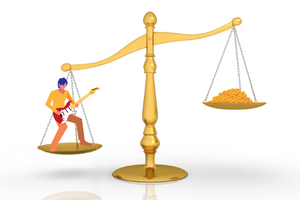
Keeping Things Musical
Great guitarists who play for amusement or to entertain others know how to use effect pedals to keep their songs musical.
This is one of the main things that defines the number of effects pedals in their arsenal. They understand how to use the proper effects pedals in the right places and how it relates to the art of making music. Too little, and something sounds missing. Too much, and the point of the song is lost.
What Are Guitar Pedals?

Guitar pedals, also called stomp boxes, are electronic devices connected between the guitar and amplifier or put in the amp’s effects loop.
They modify a guitar’s audio signal to give it a unique sound, like distortion and echo, or to make the signal cleaner, like a noise gate pedal.
Pedals, like overdrive, can push the front end of an amplifier to give it characteristics of breakup and sustain. Other pedals, like reverb, change the guitar’s sound without modifying the amp’s performance characteristics.
Initially, they were analog (non-digital). Digital stomp boxes and effects modelers came later.
Types Of Pedals

Here are the most common pedal types with a brief description of what they do. You can click on each pedal type to read why and how guitar players use them. I included the Amazon links if you’re interested in getting more info.
| Pedal Type | Usage | Function |
|---|---|---|
| Reverb | ✅✅✅ | Adds reverberation to audio signal |
| Delay | ✅✅✅✅ | Adds delay and echo to audio signal |
| Tremolo | ✅ | Makes audio signal louder and softer |
| Chorus | ✅✅✅ | Multiplies and modulates audio signal (for “thicker” sound) |
| Phase Shifter | ✅✅✅ | Frequency-based modulation (makes “whooshing” sound) |
| Flanger | ✅✅✅ | Time-based modulation (makes “flanging” sound) |
| Overdrive | ✅✅✅✅ | Boosts signal and adds sustain |
| Distortion | ✅✅✅✅ | Clips signal with mild to moderate distortion |
| Metal | ✅✅✅✅ | Aggressive distortion with high and low-frequency cuts |
| Fuzz | ✅✅ | Clips signal with severe distortion |
| Wah-wah | ✅✅✅ | Varies guitar signal tone |
| Compressor | ✅✅ | Keeps sound level constant and adds sustain |
| Graphic EQ | ✅✅ | Adjusts the lows, mids, and highs |
| Noise Gate | ✅✅✅ | Removes noise from guitar signal |
| Digital Tuner | ✅✅✅✅ | Tunes guitar |
Pros And Cons Of Effects Pedals
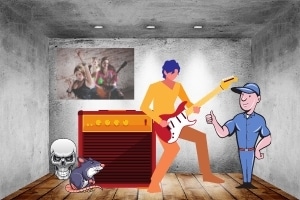
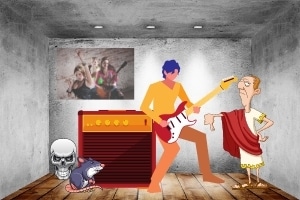
Here are some pros and cons guitar players consider when deciding to use pedals.
| Effects Pedals | Pros | Cons |
|---|---|---|
| Pedal Number | More pedals give more effects | Each pedal adds noise and can weaken the audio signal |
| Battery Powered | Quieter and more compact | Pedal will fail if battery dies |
| D.C. Power Supply | Ideal for pedalboard use | Noisier than battery-powered pedals |
| Practice Time | Can make you practice longer | Can interfere with lesson material |
| Creativity | Can stimulate creativity | Can distract from song’s musical content |
| Overdrive/Distortion | More adjustable than an amp | Not as organic-sounding as a tube amp |
Reverb, Delay, And Tremolo
Reverb, delay, and tremolo are modulation pedals. Out of these three, you’ll most likely find a digital delay pedal on a guitar player’s pedalboard. Many amplifiers have built-in reverb, making it less favored, and tremolo seems to be the least popular of the three.
Reverb Pedals
(Commonly used in Rock, Metal, and Jazz)
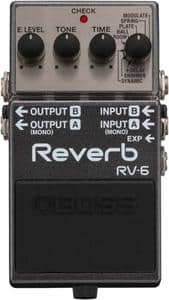
Click HERE To Check Reviews & Price On Amazon
Guitar players use reverb to add ambiance to the room, making their sound appear larger. Surf music players, like Dick Dale and Gary Hoey, use a lot of reverb. The reverb pedal above can create a stereo signal to further exaggerate the effect’s sound.
Some players use a reverb pedal, even if their amplifier already has a reverb control. This is because the pedal has more than one reverb type (spring, plate, hall, room, etc.).
Reverb effects combine excellently with delay and dirt pedal sounds.
Tremolo Pedals
(Rarely used by players of all genres)

Click HERE To Check Reviews & Price On Amazon
Tremolo pedals give you a modulation that varies the volume of notes up and down. It’s like what happens if you turn your guitar volume knob up and down or use a volume pedal, except with a tremolo pedal, you can precisely set the rate and depth and even change the wave (alters LFO waveform from triangle to square) of the sound.
It’s not a super popular pedal these days, so it’s unlikely to appear on the average pedalboard. In the 60s, tremolo was more popular and was commonly built into guitar amps. Still, it’s a great effect to use sparingly.
Sixties bands like Buffalo Springfield frequently used delay pedals.
Delay Pedals
(Very commonly used, especially in Rock and Metal)
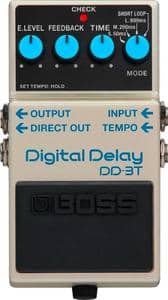
Click HERE To Check Reviews & Price On Amazon
Delay essentially works by repeating a note(s) after a specified time period. If the time is long enough, it sounds like an echo.
A Delay pedal is commonly used in Rock, Metal, and Jazz-fusion. You’re almost sure to find it on the average effects pedalboard!
The first analog delay effects were done with tape delay machines. Modern digital delay pedals are entirely electronic. I love using a digital stereo delay, like the one above, hooked up to two different amps to get a wicked back-and-forth “ping pong effect.
If the amps have an effects loop, that’s where they sound best!
You can hear delay pedals used in bands like Pink Floyd (David Gilmour) and Steve Vai.
Chorus, Phase Shifter, And Flanger
It’s common to find at least one of these three modulation pedals on a Rock, Metal, or even Jazz guitar player’s pedalboard.
Chorus Pedals
(Commonly used pedal in Rock, Metal, and Jazz)
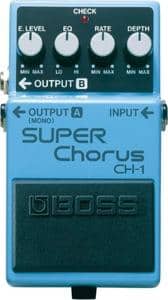
Click HERE To Check Reviews & Price On Amazon
A chorus pedal multiplies and modulates a guitar’s audio signal to give it a “thicker” sound as if it was being sung in the same octave by several people simultaneously. It’s another way to sound bigger and make your playing stand out.
Chances are, most pro guitarists will have one on their pedalboard. I think Chorus pedals seem more popular than phase shifters and flangers because they create a more subtle and generally more usable effect.
The stereo chorus pedals, like the one above, sound pretty cool!
You can hear chorus pedals used in bands like Metallica (James Hetfield, Kirk Hammett) and Nirvana (Kurt Cobain).
Phase Shifter (Phaser) Pedals
(Commonly used pedal in Rock and Metal)
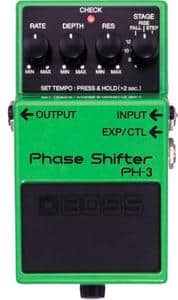
Click HERE To Check Reviews & Price On Amazon
You’re probably familiar with the whooshing” sound of a phase shifter. It works by frequency-based modulation. The first phase shifter I owned was the MXR Phase 90. Phase shifters seem to be less popular than chorus pedals.
You can hear phase shifter pedals used in bands like Rush (Alex Lifeson) and Led Zeppelin (John Paul Jones).
Flanger Pedals
(Commonly used pedal in Rock and Metal)
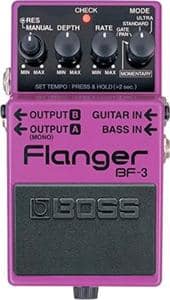
Click HERE To Check Reviews & Price On Amazon
Unlike the phase shifter, flangers use time-based modulation to make their “flanging” sound). Flangers are less popular than chorus pedals.
I love the sound of a flanger combined with a good distortion pedal!
You can hear flanger pedals used in bands like Van Halen (Eddie Van Halen) and Queen (Brian May).
Overdrive, Distortion, Metal, And Fuzz
Dirt (overdrive, distortion, and fuzz) pedals are king when it comes to Rock and Metal! They put the “power” in power chords and add sustain and harmonics to guitar solos! It’s not uncommon to find three or four dirt pedals on a guitar player’s pedalboard.
Overdrive Pedals
(Very commonly used in Rock, Blues, Metal, and Country)

Click HERE To Check Reviews & Price On Amazon
Overdrive pedals are the most all-around used dirt pedals!
They add a little kick in the pants to anything being played on the guitar. These pedals can be set to be fairly transparent (don’t really color the tone of the notes played) or to add dirt to get a nice crunchy sound.
Combining an overdrive pedal with a distortion pedal gives a great over-saturated sound.
I especially love the Boss Super Overdrive because it’s so versatile.
You can hear overdrive pedals used in bands like Van Halen and Eric Johnson.
Distortion Pedals
(Very commonly used in Rock and Metal)
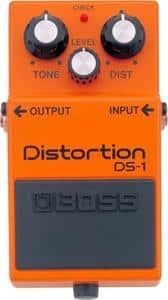
Click HERE To Check Reviews & Price On Amazon
Distortion pedals are the grandaddy of dirt and favorites among Metal and Rock players. They can give you everything from an over-saturated sound to pure distortion.
I buy more distortion pedals than any other type. They all sound so different from each other!
The Boss DS-1 Distortion pedal is one of the most classic sounds out there!
Combining (gain stacking) two or more distortion pedals can create a sonic meltdown!
You can hear distortion pedals used in bands like The Scorpions (Rudolf Schenker) and Joe Satriani.
Metal Pedals
(Very commonly used Metal and Rock)
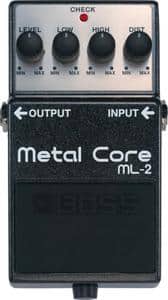
Click HERE To Check Reviews & Price On Amazon
“Metal” effects pedals are essentially more aggressive distortion pedals with high and low-frequency cut adjustments.
If you want to get that nice “mid-scooped” and almost demonic sound, this is the pedal for you, especially if you like to tune down your guitar!
A good metal pedal can sound devastating with humbucker pickups and high-gain amps!
You can hear metal pedals used in bands like Korn (Brian Welch) and Slayer (Kerry King).
Fuzz Pedals
(Fairly commonly used pedal in Rock and Metal)
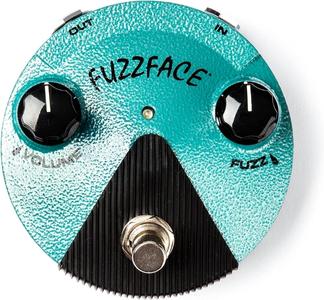
Click HERE To Check Reviews & Price On Amazon
Fuzz is essentially distortion taking to the next level of dirtiness but with fewer tonal options and variable sustain. It is not as popular as overdrive or distortion.
The first fuzz pedal I ever bought was the Gibson Maestro Fuzz Tone.
You can hear fuzz pedals used in bands like The Who (Pete Townshend) and Jimi Hendrix.
Jimi Hendrix brought the classic fuzz sound to the world with the original Arbiter Fuzz Face pedal. These days, Dunlop makes the Jimi Hendrix Fuzz Face Pedal, which can get you close to that coveted sound.
I love the sound of the Fuzz Face, and it’s such a cool-looking pedal!
Gain stacking with fuzz pedals could give you more noise than usable sound. Still, it has been done with good effect, especially in the Punk genre.
Miscellaneous Pedals
Here are some pedals that don’t fit into the above categories but are frequently sound on a guitarist’s pedalboard.
Wah-wah Pedals
(Commonly used in Rock and Metal)
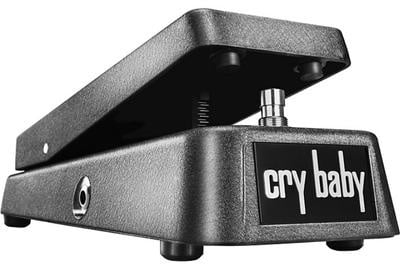
Click HERE To Check Reviews & Price On Amazon
Wah-wah pedals work by varying the tone of a guitar signal in a particular frequency range. So, technically speaking, you group it with the other modulation pedals.
If I say “Voodoo Child,” you’ll probably think of the opening lick done with a Dunlop Cry Baby or Vox King Wah-wah pedal!
You can hear Wah-wah pedals used in practically every Rock and Metal band, like Black Sabbath (Tony Iommi), Iron Maiden (Dave Murray, Adrian Smith, and Janick Gers), Jimi Hendrix, and Eric Clapton.
Compressor Pedals
(Fairly commonly used in Rock, Metal, and Country)
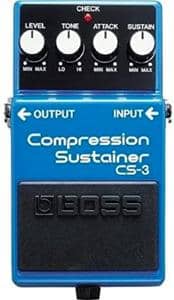
Click HERE To Check Reviews & Price On Amazon
Compressor pedals work by making softer notes louder and louder notes softer. This removes dynamics by bringing everything to the same general sound level. Compressors also add sustain to notes that can seem to last forever.
Country players love to put a compressor on their pedalboard.
I’ve used the Boss CS-3 Pedal for years, and it’s one of my favorites!
You can hear compressor pedals used by John Mayer and Joe Bonamassa.
Graphic Equalizer (EQ) Pedals
(Fairly commonly used in Jazz, Rock, and Metal)
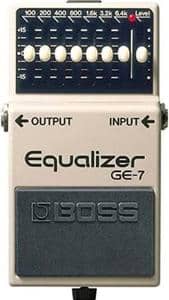
Click HERE To Check Reviews & Price On Amazon
Guitar players use graphic equalizer pedals to isolate, amplify, and attenuate various parts of the frequency spectrum. So, for example, if you’re playing a metal tune, you can scoop out the mid-range and bring out more of the bass and treble frequencies.
The Boss GE-7 is a popular choice among guitar players because it comes them seven frequency bands plus a master volume control. It’s not the most commonly seen unit on the average pedalboard, but Metal and Jazz players favor it.
You can hear graphic EQ pedals used by King Crimson (Robert Fripp) and Frank Zappa.
Noise Gate Pedals
(Commonly used in Metal and Rock)
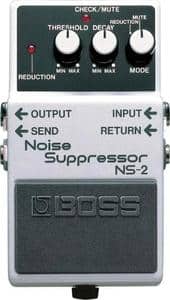
Click HERE To Check Reviews & Price On Amazon
Guitarists that play high-gain music through lots of effects, such as in Metal and Rock, commonly use a noise gate (suppressor) pedal to remove the noise and feedback in their audio signal.
This pedal is essential for players using dirt pedals for gain stacking and high-gain amplifiers.
If you’re looking for more clarity in your sound, a noise gate pedal may well be your solution.
You can hear graphic noise gate pedals used by Yngwie Malmsteen and Slipknot (Jim Root).
Digital Tuner Pedals
(Very commonly used by players of all musical genres)
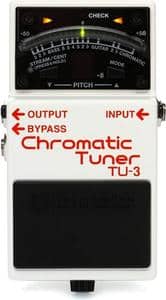
Click HERE To Check Reviews & Price On Amazon
Digital tuners are used on almost every pedalboard! They are essential for players that use guitars with whammy bars, which commonly put their instruments out of tune.
Using a clip-on guitar tuner will open up a spot on the pedalboard, but that can be inconvenient for players that change guitars frequently.
Connecting Pedals And Where To Put Them
How you connect pedals can depend on the type of amplifier you have.
Pedal Order Without An Effects Loop
Most of the older guitar amplifiers and many newer ones don’t have an effects loop.
This is probably still the most common way players connect effects pedals. They all go between the guitar and amp, but the way they are connected to each other makes a difference.
This is the order I recommend.
Guitar -> Tuner -> Wah Wah Pedal -> Compressor -> Overdirve/Distortion/Fuzz -> Modulation (tremolo, chorus, phase shifter, & flanger) -> Reverb/Delay/Tremolo -> Graphic EQ-> Amplifier Input Jack
Pedal Order With An Effects Loop
If your amp has an effects loop, you can put your stomp boxes in two separate signal paths using the following order and configuration.
Signal Path 1: Guitar -> Tuner -> Wah Wah -> Compressor -> Overdrive/Distortion/Fuzz ->
Graphic EQ -> Amplifier Input Jack
Signal Path 2: Amplifier Effects Loop “SEND” jack -> Modulation -> Reverb/Delay/Tremolo ->
Amplifier Effects Loop “RETURN” Jack
The effects loop “send” and “return” jacks can be found on the rear of the amplifier.
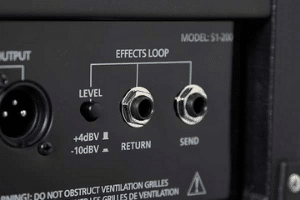
However, some players prefer not to use the effects loop and put all their pedals between the guitar and amp. Ultimately, it’s up to you, but don’t put dirt pedals in the effects loop.
Related Article ➡ How Many Guitar Pedals Do Beginners Need? – The Best Setup!
Frequently Asked Questions

Here are some of the questions I get asked about effects pedals.
If your question does not appear here, please put it in the comments, and I will get right back to you with an answer.
Can You Use Pedals With Any Amp?
Yes, effect pedals can be used with any amp. They can go between the guitar and amplifier or in the amp’s effects loop. Don’t put dirt pedals (overdrive, distortion, metal, and fuzz) in the effects loop.
Do Effect Pedals Need Power?
Yes, every effect pedal needs power. It can be internally powered by a battery, externally powered by an AC adaptor, or both.
Do Pedals Use AC Or DC?
Most effects pedals use DC (direct current) and are battery-powered or can run on a DC adaptor. Some pedals are AC (alternating current) powered and come with a special power adaptor.
Are Pedals Analog Or Digital?
Effects pedals can be analog or digital. Digital pedals are typically quieter than analog pedals, but analog pedals may be more natural sounding.
What Cables Do You Need For Effects Pedals?
When connecting pedals together, use short and high-quality cables. The most common length is six inches, but longer cables may be required to connect pedals across various areas on a pedalboard.
How Do I Choose An Effect Pedal?
Start with an effect pedal that will be most useful to your music style. For example, a distortion or metal pedal is a good choice if you play Metal. Jazz players might want to begin with a graphic EQ pedal.
Final Thoughts

I hope you found this article on why do guitarists use so many pedals useful. It’s essential to use pedals to complement the music, not overpower it.
Rock, Metal, and Blues players tend to use the most pedals to lock in on the sound they need, which can include overdrive, distortion, reverb, echo, modulation (flanger, chorus, phaser, etc.), and wah-wah.
Certain effects pedals work best with specific guitars and amplifiers, so everything has to match to correctly make the music sound great.
Individual playing style is a significant factor in choosing the correct pedals and settings. “Dirt’ pedals like overdrive and distortion, along with digital delay effects, are among the most frequently used in popular guitar music.
It’s important to understand how to connect effect pedals and where to place them in relation to the guitar and amplifier. Dirt pedals should not be put in the amp’s effect loop.
Ultimately, it’s about finding your unique sound in pedals that fit your budget.

Related Article ➡ What Is A Guitar Stomp Box – Attractive, Little, Tantalizing
Related Article ➡ Pedal Vs Amp Distortion And Overdrive – Which One Is Best?
Related Article ➡ Can You Use Single Coil Pickups For Rock? – Ultimate Guide!
Here’s a Fender video demonstrating their Hammertone Fuzz, Overdrive, Distortion, and Metal effects pedals. Check it out!
Tell Me What You Think

Please leave a comment below if you enjoyed this article, have any questions about effects pedals, or want to give your point of view. I will be happy to help you.
- Are you using effects pedals? Which ones?
- Can you ever have too many effects pedals?
- Did this article help you understand how guitar players use effects pedals?
- What else is on your mind?



Pedals have made music interesting and soulful. There is a high difference between a guitarist who uses a pedal and one who plays without a pedal. Many musicians are now beginning to see the useful and importance of a guitar pedal. So as a beginner soon you’ll come to the understanding that pedals makes playing the guitar less stressful and also soulful.
Hi, Apexvilla
Thank You for your comments!
Yes, guitar pedals definitely have their use in all genres of music. Although they are certainly not obligatory, they can help you take your music to the next level.
Beginning players should take care not to let pedals dictate the allocation of their practice time or determine their musical direction.
Keep On Rockin! 🤘
Frank 🎸
I was unaware of the sophistication of pedals and how they are used. I have always loved the sound produced by ZZ Top, now I know why I love it. If a guitarist does not learn how to use the pedals correctly then their music will not reach the iconic stage they are looking for. I must say my awareness of guitarists’ work ethic and knowledge has reached a new height.
Jerry
Hi, Jerry
Thank You for your comments!
Yes, effects pedals can create new and exciting sounds. It’s important not to let them interfere with the compositional process but to embellish it.
I love the fabulous sound Billy Gibbons gets in ZZ Top! If he plugged into an amp without any pedals, I’ll bet he would still sound uniquely like himself.
Keep On Rockin’ 🤘
Frank 🎸